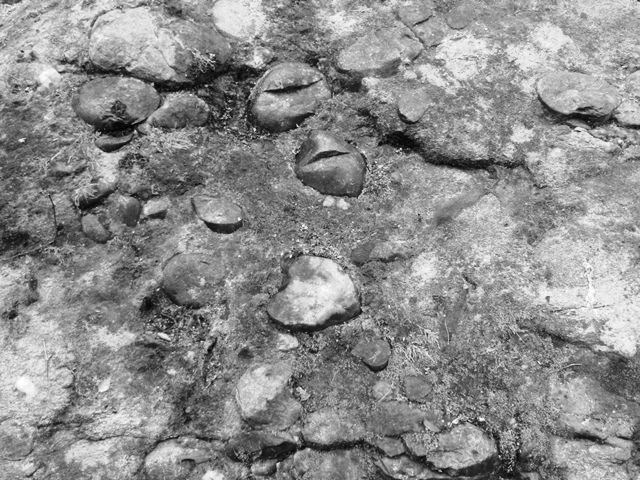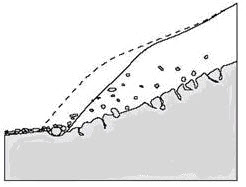
SVE
Konglomerat stenformation
Detta flyttblock är en typ av sedimentär sten som kallas för konglomerat. Även om konglomerat stenar kommer i många färger och stil, är de alla formad från delar av äldre stenar och mineraler. En konglomerat hör till de klastiska bergarter och innehåller stora (större än 2 mm i diamater) rundader klaster av en annan bergart. Utrymmet mellan klasterna brukar bestå av mindre partiklar, en blandning av sand, lera och en kemisk cement som binder allting tillsammans. Konglomerat bildas genom fyra steg; vittring, transport, deposition och litifiering. Om man studerar beståndsdelarna i detta flyttblock, kan man förstå några av förhållanden som fanns under tiden det bildades..
Vittring
Jordens skorpa genomgår fysiska- och kemiska vittringsprocesser som får stenen att brytas ner in mindre bitar. Fysiskvittring inkluderar gravitet (stenar fallar och bryts sonder i mindre bitar), avskavning genom vind eller vatten, frysning av vatten som orsaker frakturer, och även rötter som orsaker sprickor i stenen. Kemiskvittring inkluderar upplösning av stenar och mineraler i surt vatten mm. Om man observerar de olika beståndsdelar i detta flyttblock ser man många olika typer av äldre stenar.
Transport
Partiklarna från vittrade stenar rör sig nedför backar med hjälp av gravitet, vind och vattenkraft, i detta fall troligtvis i formen av en glacierrörelse. Hav, vattendrag, vind och även regn kan flytta partiklar från eroderade stenar. Högenergi vatten (is) kan flytta stora flyttblock och lågenergi, långsamma bäckar kan bara flytta väldigt fin material såsom sand och lera. Man kan bedömma vilken typ och energi transporten hade genom att man tittar på storleken och formen av de vittrade stenar i en konglomerat. Stenarna i detta flyttblock är ganska rund som tyder på att de transporterades av gamla vattenburen mekanismer, troligtvis under senaste isåldern.

Stenfragment bryts loss, plockas ut och transporteras neråt av glacierensrörelse
Deposition
Slutligen deponeras eller släpps sedimenten när det finns för lite energi för att flytta den. När energin som transporterar materialet tappar sin kraft för att bära dessa partiklar så ramlar de ut och bildar plana vågrätta lager. Ser du någon lager i blocket?
Kompaktering och litifiering
Vartefter mer och mer sediment ackumuleras (ibland med en tjocklek på flera kilometer ) ger den ökande tryck kompaktering av den underliggande sedimentpartiklar, som reducerar avståndet mellan partiklarna. Dessutom ökas temperatur och tryck. Vatten som innehåller upplöste kemikalier kan ändra sedimentets sammansättning. Det kan binda sedimentet tillsammans för att då skapa ett sedimentärbergart.
Klaststorlek är ett annat sätt att klassificera konglomerater. Nedan lista används för klassificering.
• Granulärkonglomerat 2–4 mm
• Gruskonglomerat 4–64 mm
• Kullerstenskonglomerat 64–256 mm
• Blockkonglomerat >256 mm
Krav på logging: Skickar svar till frågorna nedan till cacheägaren.
Vid de angivna koordinater hittar ni en stor konglomerat block.
1. Ge den ungefärlig längd, bredd och höjd på detta block.
2. Hur skulle du klassificera detta block genom klaststorleken?
3. Beskriva blockets textur- och färgegenskaper.
4. Titta på de andra flyttblock inom området. Är även de konglomerat? Ser de annorlunda ut? Varför?
ENG
Conglomerate formation
This erratic is a type of sedimentary stone that is known as conglomerate. Even if conglomerates come in many colours and forms, thay are all formed from parts of older stones and minerals. A conglomerate belongs to the clastic rocks and contain large (larger than 2 mm in diamater) rounded clasts of another type of rock. The space between the clasts usual consists of smaller particles, a mixture of sand, clay and a chemical cement that binds it all together. Conglomerates are formed in four stages; weathering, transport, deposition and lithification. If one studies the components in this erratic, one can understand some of the conditions that were found during the time it was formed.
Weathering
The earth's crust undergoes physical and chemical weathering processes that break the stone down into smaller pieces. Physical weathering includes gravity (stones fall and break into smaller pieces), erosion by wind or water, freezing of water that causes fractures, and even roots that cause cracks in the rock. Chemical weathering includes solution of stones and minerals in acidic water etc. If one observes the different constituents of this erratic one will see many different types of older stones.
Transport
Particles from weathered rocks are moved down slopes with the help of gravity, wind and water power, in this case probably in the form of a glacial movement. The sea, waterways, wind and even rain can move particles from eroded rocks. High energy water (ice) can move larger erratics and low energy, slower streams can just move very fine material like sand and clay. One can judge which type and energy the transport had by looking at the size and form of the weathered stones in a conglomerate. The stones in this erratic are quite round which means that they were transported by waterbourne mechanisms, probably during the latest ice age.

Rock fragments break loose and are picked up and transported by glacial movements
Deposition
Finally the sediment is deposited when there is too little energy to move it. When the energy to transport the material loses its ability to carry the particles they fall out and form flat horisontal layers. Can you see any clay in the block?
Compaction and lithification
As more and more sediment accumulates (sometime to a thickness of several kilometers) the increasing pressure compacts the lower sediment particles, which reduces the distance between the particles. Temperature and pressure also increase. Water that contians dissolved chemicals can change the composition of the sediments. It can also bind the sediment together to form a sedimentary rock.
Clast size is another way of classifying conglomerates. The list below is used for classification.
• Granular conglomerate 2–4 mm
• Pebble conglomerate 4–64 mm
• Cobble conglomerate 64–256 mm
• Block conglomerate >256 mm
Logging requirements: Mail the answers to the questions to the cache owner.
At the given coordinates you will find a large conglomerate block.
1. Give the approximate length, width and height of the block.
2. How would you classify this block using the clast size?
3. Describe the texture and colour of the block.
4. Look at the other erratics in the area. Are they conglomerates? Do they look different? Why?

 The most exciting way to learn about the Earth and its processes is to get into the outdoors and experience it first-hand. Visiting an Earthcache is a great outdoor activity the whole family can enjoy. An Earthcache is a special place that people can visit to learn about a unique geoscience feature or aspect of our Earth. Earthcaches include a set of educational notes and the details about where to find the location (latitude and longitude). Visitors to Earthcaches can see how our planet has been shaped by geological processes, how we manage the resources and how scientists gather evidence to learn about the Earth. To find out more click HERE.
The most exciting way to learn about the Earth and its processes is to get into the outdoors and experience it first-hand. Visiting an Earthcache is a great outdoor activity the whole family can enjoy. An Earthcache is a special place that people can visit to learn about a unique geoscience feature or aspect of our Earth. Earthcaches include a set of educational notes and the details about where to find the location (latitude and longitude). Visitors to Earthcaches can see how our planet has been shaped by geological processes, how we manage the resources and how scientists gather evidence to learn about the Earth. To find out more click HERE.